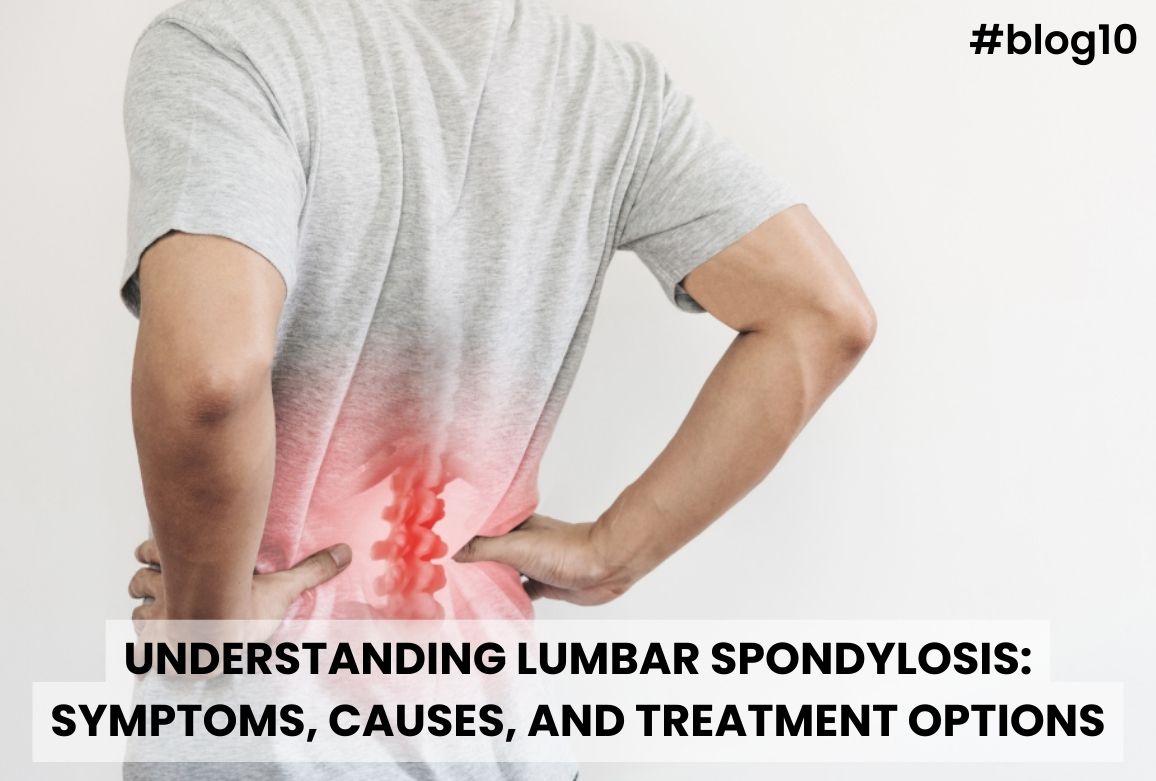- Mon - Sat 10:00 am - 08:00 pm |
Sunday 10:00 am - 01:00 pm - +(91) 9554015920
- drpaulphysiotherapy@gmail.com

Lumbar spondylosis is a common degenerative condition affecting the spine, particularly in the lower back region. It is a type of osteoarthritis that occurs due to the wear and tear of the spinal discs and vertebrae over time. As we age, the spine undergoes changes that can lead to discomfort, pain, and decreased mobility. Understanding the symptoms, causes, and treatment options for lumbar spondylosis is crucial for managing this condition effectively.
The symptoms of lumbar spondylosis can vary from mild to severe and may include:
● Lower Back Pain: Persistent or intermittent pain in the lower back is a primary
symptom. This pain can radiate to the buttocks and legs.
● Stiffness: Reduced flexibility and stiffness in the lower back, especially after periods
of inactivity or in the morning.
● Numbness and Tingling: Numbness, tingling, or a pins-and-needles sensation in
the legs and feet.
● Weakness: Muscle weakness in the legs, which can affect walking and balance.
● Loss of Bladder or Bowel Control: In severe cases, spondylosis can compress the
spinal cord, leading to loss of bladder or bowel control, a condition known as cauda
equina syndrome, which requires immediate medical attention.
● Aging: Natural aging processes lead to the gradual wear and tear of spinal discs and
joints.
● Genetics: A family history of spinal problems increases the risk of developing
spondylosis.
● Repetitive Strain: Occupations or activities that involve repetitive bending, lifting, or
twisting can accelerate spinal degeneration.
● Injury: Previous spinal injuries can predispose individuals to spondylosis.
● Obesity: Excess weight puts additional stress on the spine, contributing to
degenerative changes.
● Medical History: Detailed discussion of symptoms and medical history.
● Physical Examination: Assessment of spine mobility, reflexes, and muscle strength.
● Imaging Studies: X-rays, MRI, or CT scans to visualise spinal degeneration, bone
spurs, and disc damage. If you're in Janakpuri, you can find advanced imaging
facilities at the best physiotherapy clinic in janakpuri equipped to diagnose lumbar
spondylosis accurately.
● Medications: Pain relievers, anti-inflammatory drugs, and muscle relaxants.
● Physical Therapy: Exercises to strengthen the back and improve flexibility.If you're
in Delhi, the best physiotherapy clinic in Janakpuri offers specialized treatments
for lumbar spondylosis.
● Lifestyle Modifications: Weight management, ergonomic adjustments, and avoiding
activities that exacerbate symptoms.
● Injections: Corticosteroid injections to reduce inflammation and pain.
● Decompression Surgery: Removing bone spurs or parts of the vertebrae to relieve
pressure on nerves.
● Spinal Fusion: Fusing two or more vertebrae to stabilize the spine.
Prevention While aging cannot be stopped, certain measures can help reduce the risk of developing
lumbar spondylosis.
● Maintain a Healthy Weight: Reducing stress on the spine by avoiding obesity.
● Stay Active: Regular exercise to strengthen back muscles and maintain flexibility.
● Use Proper Body Mechanics: Avoiding heavy lifting and using proper techniques
when lifting objects.
● Healthy Diet: Consuming a balanced diet rich in calcium and vitamin D to support
bone health.
Lumbar spondylosis is a common condition that can significantly impact daily life. Early diagnosis and a combination of non-surgical and surgical treatments can help manage symptoms effectively. By understanding the causes, recognizing the symptoms, and adopting preventive measures, individuals can take proactive steps to maintain spinal health and improve their quality of life. If you experience persistent back pain or other related symptoms, consult a healthcare professional for a comprehensive evaluation and personalized treatment plan. For those seeking expert care, the best physiotherapy clinic in Janakpuri offers excellent services tailored to managing lumbar spondylosis.